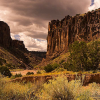Kaibab Plateau, Arizona
The Kaibab Plateau is a plateau in northern Arizona located within the larger Colorado Plateau. The Kaibab Plateau is split between the Kaibab National Forest to the north and Grand Canyon National Park to the south. The eastern and western sides of the plateau are bounded by tributaries of the Colorado River, and the northern edge is bounded by cliffs. Located at approximately 8,000 feet in elevation, the plateau is home to a range of forest types including aspen and mixed conifer stands, open stands of old-growth ponderosa pine, and a transitional zone of pinyon pine and juniper scrub near the North Rim of the Grand Canyon.










